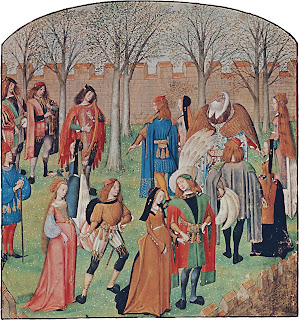Roman de la Rose was a transformational 13th century work written by 2 different people 45 years apart springing no doubt from the Poitier’s court of the incandescent Eleanor of Aquitaine. The work came at the beginning of the literary tradition of “courtly love”concurrent with the first bloom of Arthurian legend (Chretién de Troyes and Geoffrey of Monmouth were nearly contemporaries) and remarkable for the way it explored love in its many forms.
First page of University of Chicago Library copy
Its popularity was extraordinary since it predated the printing press by hundreds of years and circulated only through beautiful illuminated books (hundreds of which still exist today).
"Love Roundplay", from French book illustration, master of the "Roman de la Rose", c. 1420/30; Archiv fur Kunst und Geschichte, Berlin.
Circulate it did, in spite of the church throwing up rather unfortunate draconian rules and regulations regarding sex with really, really unfortunate consequences for those who disregarded them (roasting, chopping, flaying, castrating, filling with hot lead...all while still alive).
14th C. Copy, University of Chicago
Perhaps these rules were in direct response to the life-style portrayed in Roman de la Rose and other kindred works that glorified romantic love and flirted with barely disguised sexuality.
Roman de la Rose begins as an allegorical dream set within a walled garden (locus amoenus, or ‘pleasant place’ with Garden-of-Eden leanings) that represents romantic life. What lies beyond is ‘la vie ordinaire’.
Enclosed Garden, BL MS Egerton 1069, 1400
In the dream, a young man gazes into The Fountain of Narcissus and falls in love with a rosebud. He never consummates his desire (one of the fundamentals of courtly love is that love be unrequited yet transcendant and usually secret). The second and later part opens the work up to the world and its eroticism is richer with many associations with the Latin poet Ovid’s The Art of Love . Interestingly, the rose in this book is not just a symbol of the female, closed it signifies the male.
Declan McCullagh photograph
The rose became associated with love as it was the favorite flower of Venus, the goddess of love in Roman mythology. It has remained so evermore and the idea of giving roses to one’s beloved probably had roots in the language of flowers that dates back to antiquity and eventually grafted itself onto Valentine’s Day. Red roses still imply passionate, romantic love and pink roses a lesser affection; white roses suggest virtue and chastity and yellow roses still stand for friendship or devotion.
For most of us, the ultimate romantic aphrodesiac is chocolate but Europe wouldn’t know its seductive properties until Columbus brought it back from the New World. Theobroma cacao in Greek means ‘food of the gods’. You probably see where I’m going with this. Roses are flowers of the gods, and chocolate…well, Elaine Sherman, “Madame Chocolate”, wrote “Chocolate is heavenly, mellow, sensual, deep, dark, sumptuous, gratifying, potent, dense, creamy, seductive, suggestive, rich, excessive, silky, smooth, luxurious, celestial. Chocolate is downfall, happiness, pleasure, love, ecstasy, fantasy … chocolate makes us wicked, guilty, sinful, healthy, chic, happy.” The Aztecs thought that it was a source of spiritual wisdom and sexual power
For Valentine’s Day, I will share with you my favorite cupcake, gathered long ago from the pages of the old Victoria Magazine. There is nothing better than chocolate flavored with roses… well almost nothing… and these will get you in the mood for, well, you know. I used Mandy Aftel’s Rose Absolute for the cupcakes for the first time and was over the moon with the results after using rosewater for many years… try to use it if you can.
Happy Valentines Day!!!!!
Romance of the Rose Chocolate Cupcakes
1 ½ c Flour
½ c Cocoa powder
1 ½ t. baking powder
¼ t salt
2 L eggs
1 c sugar
¾ c buttermilk
½ t. vanilla
1 stick butter
2 oz. chocolate, chopped
Set your oven at 350º. Sift the flour, cocoa and baking powder and salt in one bowl. Combine the sugar and the eggs and beat till golden and smooth, add the buttermilk and vanilla. Melt the butter and add the chocolate stir till melted with a gentle heat then add the dry ingredients then the wet. Makes 12-15 cupcakes. Cook for 25 minutes or until toothpick comes out clean.
Frost with:
Rose Frosting
1 cup powder sugar, sifted
4 T butter, softened
1 T Cream or milk if frosting is too stiff
3 drops Rose Absolute or 2 t. rosewater (do this to your taste)
Rosebuds for decoration
Whip together till a smooth frosting develops and frost your cupcakes. Eat and swoon.
*** If you are laying on the frosting with abandon as I did, you will need to triple the recipe.
Supposedly, the earliest Valentine card is in the British Museum and was written by the Duke of Orleans to his wife in France when he was locked in the Tower in 1415
Je suis desja d'amour tanné
Ma tres doulce Valentinée…
Duke of Orleans letter in British Museum
I will announce the winner of the Jasmine and Rose Absolutes this weekend!!!
















0 comments:
Post a Comment